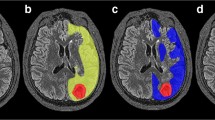Summary
In order to study the haemodynamic and metabolic changes following bypass surgery, the regional cerebral blood flow (rCBF), the oxygen extraction fraction (rOEF), the cerebral metabolic rate of oxygen (rCMRO2), and the cerebral blood volume (rCBV) were measured using a positron emission tomograph (PET) on 13 patients who had unilateral internal carotid artery and/or middle cerebral artery occlusion. The patients were divided into two subgroups according to pre-operative rOEF values from the arterial occlusion side: the misery perfusion group, which had high rOEF values (≧0.56), and the coupling perfusion group, which had normal rOEF values (0.38–0.48). A post-operative PET study was performed 1–2 months and/or 1–5 years following the surgery. Six of the misery perfusion cases showed a post-operative CBF increase, where an accompanying OEF decreased to its normal level, indicating an attenuated misery perfusion state. The CMRO2 values, however, remained low. The other 7 coupling perfusion cases had an ipsilateral CBF increase in the earlier PET study. We conclude that misery perfusion is attenuated following bypass surgery, although the procedure does not consistently improve oxygen metabolism.
Similar content being viewed by others
References
Baron JC, Bousser MG, Comar D, Soussaline F, Castaigne P (1981 a) Noninvasive tomographic study of cerebral blood flow and oxygen metabolism in vivo. Potentials, limitations, and clinical applications in cerebral ischemic disorders. Eur Neurol 20: 273–284
Baron JC, Bousser MG, Rey A, Guillard A, Comar D, Castaigne P (1981 b) Reversal of focal “misery-perfusion syndrome” by extra-intracranial arterial bypass in hemodynamic cerebral ischemia. A case study with15O positron emission tomography. Stroke 12: 454–459
Gibbs JM, Wisw RJS, Leenders KL, Jones T (1984) Evaluation of cerebral perfusion reserve in patients with carotid-artery occlusion. Lancet 1: 310–314
Gibbs JM, Wise RJS, Thomas DJ, Mansfield AO, Russell RWR (1987) Cerebral haemodynamic changes after extracranial-intracranial bypass surgery. J Neurol Neurosurg Psychiatry 50: 140–150
Higano S, Uemura K, Shishido F, Inugami A, Tomura N, Fujita H, Abe T, Kanno I (1987) Studies on cerebral bloos flow and oxygen metabolism in patients with chronically obstructive carotid disease, using postron emission tomography (PET) — in consideration of the indication for EC/IC bypass surgery. Jpn J Nucl Med 24: 809–815
Kanno I, Miuras S, Yamamoto S, Iida H, Murakami M, Takahashi H, Uemura K (1985) Design and evaluation of a positron emission tomography: HEADTOME III. J Comput Assist Tomogr 9: 931–939
Kanno I, Uemura K, Higano S, Murakami M, Iida H, Miura S, Shishido F, Inugani A, Sayama I (1988) Oxygen extraction fraction at maximally vasodilated tissue in the ischemic brain estimated from the regional CO2 responsiveness measured by postron emission tomography. J Cereb Blood Flow Metab 8: 227–235
Leblanc R, Tyler JL, Mohr G, Meyer E, Diksic M, Yamamoto L, Taylor L, Gauthier S, Hakim A (1987) Hemodynamic and metabolic effects of cerebral revascularization. J Neurosurg 66: 529–535
Powers WJ, Martin WRW, Herscovitch P, Raichle ME, Grubb RL (1984) Extracranial-intracranial bypass surgery: hemodynamic and metabolic effects. Neurology (Cleveland) 34: 1168–1174
Powers WL, Press GA, Grubb RL Jr, Gado M, Raichle ME (1987) The effect of hemodynamically significant carotid artery disease on the hemodynamic status of the cerebral circulation. Ann Int Med 106: 27–35
Powers WJ, Grubb RL, Raichle ME (1989) Clinical results of extracranial-intracranial bypass surgery in patients with hemodynamic cerebrovascular disease. J Neurosurg 70: 61–67
Samson Y, Baron JC, Bousser MG, Rey A, Derlon JM, David P, Comoy J (1985) Effects of extra-intracranial arterial bypass on cerebral blood flow and oxygen metabolism in humans. Stroke 16: 609–616
The EC/IC Bypass Study Group (1985) Failure of extracranial-intracranial arterial bypass to reduce the risk of ischemic stroke. Results of an international randomized trial. N Engl J Med 313: 1191–1200
Yamaguchi T, Kanno I, Uemura K, Shishido F, Inugami A, Ogawa T, Murakami M, Suzuki K (1986) Reduction in regional cerebral metabolic rate of oxygen during human aging. Stroke 17: 1220–1228
Yamauchi H, Fukuyama H, Kimura J, Konishi J, Kameyama M (1990) Hemodynamics in internal carotid artery occlusion examined by positron emission tomography. Stroke 21: 1400–1406
Author information
Authors and Affiliations
Rights and permissions
About this article
Cite this article
Kawamura, S., Sayama, I., Yasui, N. et al. Haemodynamic and metabolic changes following extra-intracranial bypass surgery. Acta neurochir 126, 135–139 (1994). https://doi.org/10.1007/BF01476423
Issue Date:
DOI: https://doi.org/10.1007/BF01476423




